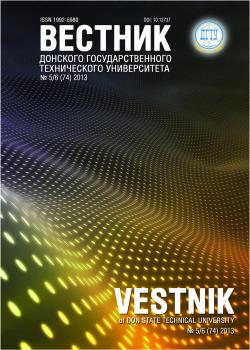The research results on determining the dependence of gas-thermal coating porosity on the laser radiation parameters are presented. At the first stage of solving the problem, on the basis of the analytical relationships, laser impact on the surface layers of the gas-thermal coating is described. Here, its discontinuity caused by the occurrence of open and closed pores is recognized. It is shown that for reducing the coating porosity under the laser impact, the coating surface temperature is to be set in the range of “fusion point-boiling point”. A temperature rise above this range caused by the radiation intensity increase leads to evaporation of surface coating layers through its complete removal in the heat effected zone. At the second stage, field research is conducted: pre-sprayed gas-thermal coatings of two types are processed by laser. The coatings based on the metallic (PN-85-U-15) and non-metallic (Al2O3) components are studied. The porosity modification is evaluated quantitatively using the image processing program developed in Visual Studio 2008 by pixel comparison of microstructure of the area occupied by pores and the coating material. It is established that the laser impact leads to decreasing in the average porosity of the gas-thermal coatings. Porosity of the coating based on the PN-85-U-15 alloy decreases from 17 % at the initial state to 5–8 % after the laser treatment. The corresponding figures for the ceramic coating Al2O3 are 24.5 % and 15–18 %.
laser radiation, gas-thermal coating, porosity of gas-thermal coating.
Введение. Одним из перспективных способов получения защитных и износостойких покрытий повышенной прочности является плазменный метод их нанесения [1, 2]. Эффективность применения функциональных газотермических покрытий определяется не только свойствами напыляемого материала, но и характеристиками покрытия. Например, теплозащитная способность и коррозионная стойкость покрытия во многом определяются его пористостью. С увеличением пористости улучшаются теплозащитные свойства покрытия, в частности термостойкость, сопротивляемость растрескиванию при термоциклических нагрузках. С другой стороны, развитая наружная и внутренняя пористость облегчает возможность проникновения атмосферных газов или агрессивных сред через покрытие к поверхности металлической основы, что приводит к образованию на границе раздела оксидных плёнок, снижению прочности адгезионного сцепления и отслаиванию покрытия [3]. Оплавив некоторый объём частиц в составе покрытия, можно снизить его пористость. Одним из путей эффективного повышения эксплуатационных характеристик поверхностных слоёв конструкционных материалов является применение комбинированных методов обработки — с сочетанием различных физико-химических процессов [4]. Дисперсные напылённые покрытия достаточно оплавлять. При этом следует исключить объёмный нагрев до температуры плавления покрытий, чтобы избежать их отслаивания вследствие подплавления подложки и значительной её термодеформации. Известно, что воздействие концентрированными потоками энергии, в частности лазерным излучением, обеспечивает высокотемпературный нагрев, отличающийся малой зоной термического влияния [5].
1. Kudinov, V. V. Plazmennye pokrytiya. [Plasma coatings.] Moscow: Nauka, 1977, 184 p.(in Russian).
2. Ryzhkin, A. A., Ilyasov, A. V. Fazovy sostav metallomatrichnykh kospozitov sistemy «Fe-W-C», formiruyemykh plazmennym osazhdeniyem. [Phase makeup of «Fe-WC» system metal matrix composites formed by plasma deposition.] Vestnik of DSTU, 2007, vol. 7, no. 2 (33), pp. 169-176 (in Russian).
3. Puzryakov, A. F. Teoreticheskie osnovy tekhnologii plazmennogo napyleniya: Uchebnoe posobie po kursu “Tekhnologiya konstruktsiy iz metallokompozitov”. [Theoretical foundations of plasma spray technology: training manual on the course “Technology of metal composite designs.”] Moscow : Izd-vo MGTU im. N.E. Baumana, 2003, 360 p. (in Russian).
4. Smolentsev, Y. V. Klassifikatsiya kombinirovannykh metodov obrabotki. [The classification of combined processing methods.] Vestnik of DSTU, 2010, vol. 10, no. 1 (44), pp. 76-79 (in Russian). Grigoryants, A. G., Shiganov, I. N., Misyurov, A. I. Tekhnologicheskie protsessy lazernoy obrabotki: Ucheb. Posobie dlya vuzov. [Laser processing: textbook for universities.] A. G. Grigoryants, ed. Moscow : Izd-vo MGTU im. N.E. Baumana, 2006, 664 p. (in Russian).
5. Grigoryants, A. G., Shiganov, I. N., Misyurov, A .I. Tekhnologicheskie protsessy lazernoy obrabotki: Ucheb. Posobie dlya vuzov. [Laser processing: textbook for universities.] A.G. Grigoryants, ed. Moscow : Izd-vo MGTU im. N.E. Baumana, 2006, 664 p. (in Russian).
6. Balashova, S. A., Mitrofanov, A. A., Chaschin, E. A. Obrabotka gazotermicheskikh pokrytiy s ispol´zovaniem lazernogo izlucheniya. [Laser machining of thermal spray coatings.] Vestnik of ISPEU, 2011, no. 1, pp. 103-105 (in Russian).
7. Mitrofanov, A. A., Chaschin, E. A. Obrabotka gazotermicheskikh pokrytiy neprerivnim izlu-cheniem CO2-lazera. [Thermal coating processing through continuous CO2 laser radiation.] Vestnik mashinostroeniya, 2013, no. 4, pp. 25-27 (in Russian).
8. Mitrofanov, A. A., Chaschin, E. A., Balashova, S. A. Laser treatment of plasma coating. 1st Int. Russian-Chinese Conf. “Youth school-workshop Modern laser physics and laser information technologies for science and manufacture.” Vladimir (Russia), Sept. 23-28, 2011, pp. 86-88.
9. Balashova, S. A., et al. Povysheniye ekspluatatsionnykh kharakteristik keramicheskikh pokryty. [Production characteristics increase of ceramic coatings.] Vestnik of Saratov State Technical University, 2009, iss. 1, no. 2 (38), pp. 72-79 (in Russian).
10. Krishtal, M. A., Zhukov, A. A., Kokora, A. N. Struktura i svojstva splavov, obrabotannyh izlucheniem lazera. [Structure and properties of alloys processed by laser radiation.] Moscow : Metallurgija, 1973, 192 p. (in Russian).
11. Belov, S. V., ed. Poristye pronitsaemye materialy: Spravochnik [Porous permeable materials: handbook.] Moscow : Metallurgiya, 1987, 335 p. (in Russian).





